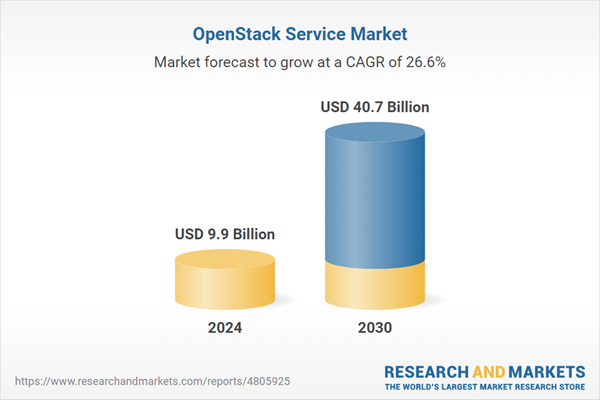The global market for OpenStack Service was valued at US$9.9 Billion in 2024 and is projected to reach US$40.7 Billion by 2030, growing at a CAGR of 26.6% from 2024 to 2030. This comprehensive report provides an in-depth analysis of market trends, drivers, and forecasts, helping you make informed business decisions. The report includes the most recent global tariff developments and how they impact the OpenStack Service market.
Segments: Component (Solutions, Services); Organization Size (SMEs, Large Enterprises); Vertical (Information Technology, Telecommunications, Academic & Research, BFSI, Retail, Other Verticals).
Geographic Regions/Countries: World; United States; Canada; Japan; China; Europe (France; Germany; Italy; United Kingdom; and Rest of Europe); Asia-Pacific; Rest of World.
The analysts continuously track trade developments worldwide, drawing insights from leading global economists and over 200 industry and policy institutions, including think tanks, trade organizations, and national economic advisory bodies. This intelligence is integrated into forecasting models to provide timely, data-driven analysis of emerging risks and opportunities.
Global OpenStack Service Market - Key Trends & Drivers Summarized
How Is OpenStack Transforming Cloud Computing?
OpenStack, an open-source cloud computing platform, has gained significant traction in recent years as businesses seek flexible and cost-effective alternatives to proprietary cloud solutions. Initially developed by NASA and Rackspace, OpenStack provides a framework for creating and managing public, private, and hybrid clouds, offering a modular and scalable approach to cloud infrastructure. This open-source platform enables organizations to control large pools of compute, storage, and networking resources, all managed through a web-based dashboard or via an API. The flexibility and adaptability of OpenStack make it a popular choice for enterprises looking to avoid vendor lock-in while benefiting from the rapid innovation that comes with a collaborative open-source ecosystem. Companies across industries, from telecommunications to finance, are increasingly leveraging OpenStack to enhance their IT infrastructure and streamline operations in a cost-effective manner.What Trends Are Shaping the Future of OpenStack Services?
Several key trends are emerging in the OpenStack services market, driven by the need for more agile and efficient cloud infrastructure. One of the major trends is the growing demand for hybrid cloud solutions, where OpenStack is used in combination with public cloud services like AWS, Google Cloud, or Microsoft Azure. This hybrid approach offers the flexibility to scale workloads across different environments while maintaining control over sensitive data in private clouds. Another significant trend is the integration of container technology with OpenStack, particularly Kubernetes, which is being used to orchestrate and manage containers in the cloud. This development enables organizations to run microservices and deploy applications with greater speed and efficiency. Additionally, there is an increasing focus on edge computing, where OpenStack is deployed closer to the data source to reduce latency and improve performance, especially in industries such as IoT and telecommunications. The growing emphasis on security and compliance is also shaping the OpenStack landscape, with enhanced features for data protection and regulatory compliance becoming more critical for enterprises.How Is Technology Advancing the OpenStack Ecosystem?
Technological advancements are playing a critical role in the evolution of the OpenStack ecosystem, enhancing its scalability, performance, and ease of deployment. The integration of container orchestration tools like Kubernetes has transformed how OpenStack users deploy and manage applications, enabling more efficient use of cloud resources and faster software delivery. Continuous development of OpenStack’s modular architecture allows users to deploy only the components they need, improving flexibility and reducing complexity. Advances in automation tools, such as Ansible and Terraform, are simplifying the management of OpenStack environments, making it easier for organizations to automate infrastructure provisioning, updates, and scaling. Additionally, OpenStack's integration with emerging technologies like artificial intelligence (AI) and machine learning (ML) is enabling the development of more intelligent and adaptive cloud solutions. The platform’s compatibility with high-performance computing (HPC) workloads is also driving its adoption in research and development sectors, where data-intensive applications require robust cloud infrastructure.What Is Driving the Growth in the OpenStack Service Market?
The growth in the OpenStack service market is driven by several factors. The increasing demand for hybrid cloud solutions, which offer the flexibility to combine public and private cloud environments, is a major driver, as OpenStack provides the foundation for private cloud infrastructure. The need for scalable and cost-effective cloud solutions has led many organizations to choose OpenStack over proprietary platforms, reducing their dependency on a single vendor. The rise of containerized applications, driven by the adoption of Kubernetes, is also fueling the demand for OpenStack services, as the platform enables seamless container orchestration. Technological advancements in edge computing are further boosting the market, with OpenStack being deployed in edge locations to reduce latency and enhance data processing capabilities. Moreover, growing concerns about data security, compliance, and privacy are prompting businesses to adopt OpenStack, which offers robust security features and ensures compliance with industry regulations. Lastly, the vibrant open-source community continues to innovate and improve the platform, making it a future-proof choice for enterprises seeking cloud flexibility and control.Report Scope
The report analyzes the OpenStack Service market, presented in terms of units. The analysis covers the key segments and geographic regions outlined below.Segments: Component (Solutions, Services); Organization Size (SMEs, Large Enterprises); Vertical (Information Technology, Telecommunications, Academic & Research, BFSI, Retail, Other Verticals).
Geographic Regions/Countries: World; United States; Canada; Japan; China; Europe (France; Germany; Italy; United Kingdom; and Rest of Europe); Asia-Pacific; Rest of World.
Key Insights:
- Market Growth: Understand the significant growth trajectory of the Solutions segment, which is expected to reach US$27.3 Billion by 2030 with a CAGR of a 27.8%. The Services segment is also set to grow at 24.3% CAGR over the analysis period.
- Regional Analysis: Gain insights into the U.S. market, valued at $2.8 Billion in 2024, and China, forecasted to grow at an impressive 25.1% CAGR to reach $6.0 Billion by 2030. Discover growth trends in other key regions, including Japan, Canada, Germany, and the Asia-Pacific.
Why You Should Buy This Report:
- Detailed Market Analysis: Access a thorough analysis of the Global OpenStack Service Market, covering all major geographic regions and market segments.
- Competitive Insights: Get an overview of the competitive landscape, including the market presence of major players across different geographies.
- Future Trends and Drivers: Understand the key trends and drivers shaping the future of the Global OpenStack Service Market.
- Actionable Insights: Benefit from actionable insights that can help you identify new revenue opportunities and make strategic business decisions.
Key Questions Answered:
- How is the Global OpenStack Service Market expected to evolve by 2030?
- What are the main drivers and restraints affecting the market?
- Which market segments will grow the most over the forecast period?
- How will market shares for different regions and segments change by 2030?
- Who are the leading players in the market, and what are their prospects?
Report Features:
- Comprehensive Market Data: Independent analysis of annual sales and market forecasts in US$ Million from 2024 to 2030.
- In-Depth Regional Analysis: Detailed insights into key markets, including the U.S., China, Japan, Canada, Europe, Asia-Pacific, Latin America, Middle East, and Africa.
- Company Profiles: Coverage of players such as 99cloud, Airship, Aptira, Binary Lane, C3DNA and more.
- Complimentary Updates: Receive free report updates for one year to keep you informed of the latest market developments.
Some of the 73 companies featured in this OpenStack Service market report include:
- 99cloud
- Airship
- Aptira
- Binary Lane
- C3DNA
- Calico
- Canonical Group Ltd. - Ubuntu
- Canonical Ltd.
- Cisco Systems, Inc.
- Cloud A
Tariff Impact Analysis: Key Insights for 2025
Global tariff negotiations across 180+ countries are reshaping supply chains, costs, and competitiveness. This report reflects the latest developments as of April 2025 and incorporates forward-looking insights into the market outlook.The analysts continuously track trade developments worldwide, drawing insights from leading global economists and over 200 industry and policy institutions, including think tanks, trade organizations, and national economic advisory bodies. This intelligence is integrated into forecasting models to provide timely, data-driven analysis of emerging risks and opportunities.
What’s Included in This Edition:
- Tariff-adjusted market forecasts by region and segment
- Analysis of cost and supply chain implications by sourcing and trade exposure
- Strategic insights into geographic shifts
Buyers receive a free July 2025 update with:
- Finalized tariff impacts and new trade agreement effects
- Updated projections reflecting global sourcing and cost shifts
- Expanded country-specific coverage across the industry
Table of Contents
I. METHODOLOGYII. EXECUTIVE SUMMARY2. FOCUS ON SELECT PLAYERSIII. MARKET ANALYSISIV. COMPETITION
1. MARKET OVERVIEW
3. MARKET TRENDS & DRIVERS
4. GLOBAL MARKET PERSPECTIVE
UNITED STATES
CANADA
JAPAN
CHINA
EUROPE
FRANCE
GERMANY
ITALY
UNITED KINGDOM
REST OF EUROPE
ASIA-PACIFIC
REST OF WORLD
Companies Mentioned (Partial List)
A selection of companies mentioned in this report includes, but is not limited to:
- 99cloud
- Airship
- Aptira
- Binary Lane
- C3DNA
- Calico
- Canonical Group Ltd. - Ubuntu
- Canonical Ltd.
- Cisco Systems, Inc.
- Cloud A
Table Information
| Report Attribute | Details |
|---|---|
| No. of Pages | 212 |
| Published | April 2025 |
| Forecast Period | 2024 - 2030 |
| Estimated Market Value ( USD | $ 9.9 Billion |
| Forecasted Market Value ( USD | $ 40.7 Billion |
| Compound Annual Growth Rate | 26.6% |
| Regions Covered | Global |









